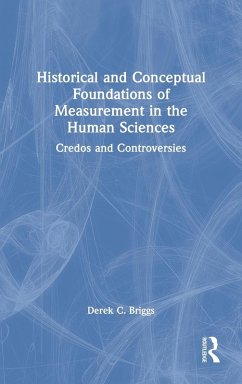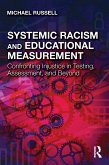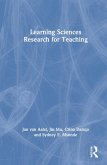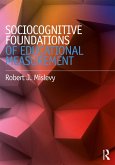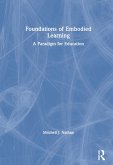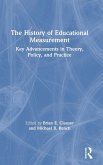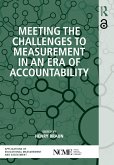Derek C. Briggs
Historical and Conceptual Foundations of Measurement in the Human Sciences
Credos and Controversies
Derek C. Briggs
Historical and Conceptual Foundations of Measurement in the Human Sciences
Credos and Controversies
- Gebundenes Buch
- Merkliste
- Auf die Merkliste
- Bewerten Bewerten
- Teilen
- Produkt teilen
- Produkterinnerung
- Produkterinnerung
Historical and Conceptual Foundations of Measurement in the Human Sciences explores the assessment and measurement of nonphysical attributes that define human beings: abilities, personalities, attitudes, dispositions, and values. The proposition that human attributes are measurable remains controversial, as do the ideas and innovations of the six historical figures-Gustav Fechner, Francis Galton, Alfred Binet, Charles Spearman, Louis Thurstone, and S. S. Stevens-at the heart of this book. Across 10 rich, elaborative chapters, readers are introduced to the origins of educational and…mehr
Andere Kunden interessierten sich auch für
![Systemic Racism and Educational Measurement Systemic Racism and Educational Measurement]() Michael RussellSystemic Racism and Educational Measurement197,99 €
Michael RussellSystemic Racism and Educational Measurement197,99 €![Learning Sciences Research for Teaching Learning Sciences Research for Teaching]() Jan van AalstLearning Sciences Research for Teaching196,99 €
Jan van AalstLearning Sciences Research for Teaching196,99 €![Sociocognitive Foundations of Educational Measurement Sociocognitive Foundations of Educational Measurement]() Robert J. MislevySociocognitive Foundations of Educational Measurement109,99 €
Robert J. MislevySociocognitive Foundations of Educational Measurement109,99 €![Foundations of Embodied Learning Foundations of Embodied Learning]() Mitchell J. NathanFoundations of Embodied Learning194,99 €
Mitchell J. NathanFoundations of Embodied Learning194,99 €![The History of Educational Measurement The History of Educational Measurement]() The History of Educational Measurement196,99 €
The History of Educational Measurement196,99 €![Meeting the Challenges to Measurement in an Era of Accountability Meeting the Challenges to Measurement in an Era of Accountability]() Meeting the Challenges to Measurement in an Era of Accountability402,99 €
Meeting the Challenges to Measurement in an Era of Accountability402,99 €![Meeting the Challenges to Measurement in an Era of Accountability Meeting the Challenges to Measurement in an Era of Accountability]() Meeting the Challenges to Measurement in an Era of Accountability83,99 €
Meeting the Challenges to Measurement in an Era of Accountability83,99 €-
-
-
Historical and Conceptual Foundations of Measurement in the Human Sciences explores the assessment and measurement of nonphysical attributes that define human beings: abilities, personalities, attitudes, dispositions, and values. The proposition that human attributes are measurable remains controversial, as do the ideas and innovations of the six historical figures-Gustav Fechner, Francis Galton, Alfred Binet, Charles Spearman, Louis Thurstone, and S. S. Stevens-at the heart of this book. Across 10 rich, elaborative chapters, readers are introduced to the origins of educational and psychological scaling, mental testing, classical test theory, factor analysis, and diagnostic classification and to controversies spanning the quantity objection, the role of measurement in promoting eugenics, theories of intelligence, the measurement of attitudes, and beyond. Graduate students, researchers, and professionals in educational measurement and psychometrics will emerge with a deeper appreciation for both the challenges and the affordances of measurement in quantitative research.
Hinweis: Dieser Artikel kann nur an eine deutsche Lieferadresse ausgeliefert werden.
Hinweis: Dieser Artikel kann nur an eine deutsche Lieferadresse ausgeliefert werden.
Produktdetails
- Produktdetails
- Verlag: Routledge
- Seitenzahl: 382
- Erscheinungstermin: 16. November 2021
- Englisch
- Abmessung: 235mm x 157mm x 25mm
- Gewicht: 703g
- ISBN-13: 9780367225247
- ISBN-10: 0367225247
- Artikelnr.: 62273819
- Herstellerkennzeichnung
- Libri GmbH
- Europaallee 1
- 36244 Bad Hersfeld
- gpsr@libri.de
- Verlag: Routledge
- Seitenzahl: 382
- Erscheinungstermin: 16. November 2021
- Englisch
- Abmessung: 235mm x 157mm x 25mm
- Gewicht: 703g
- ISBN-13: 9780367225247
- ISBN-10: 0367225247
- Artikelnr.: 62273819
- Herstellerkennzeichnung
- Libri GmbH
- Europaallee 1
- 36244 Bad Hersfeld
- gpsr@libri.de
Derek C. Briggs is Professor in the Research and Evaluation Methodology Program in the School of Education and Director of the Center for Assessment Design Research and Evaluation at the University of Colorado Boulder, USA. A former editor of the journal Educational Measurement: Issues & Practice, he is the 2021-2022 President of the National Council on Measurement in Education.
Chapter 1: What is Measurement?
1.1 Keating's War and Thorndike's Credo
1.2 What is (and What is Not) Measurement?
1.3 Educational and Psychological Measurement
1.4 Overview of this Book
Chapter 2. Psychophysical Measurement: Gustav Fechner and the Just
Noticeable Difference
2.1 Overview
2.2 The Origins of Psychophysics
2.3 The Method of Right and Wrong Cases (The Constant Method)
2.4 Criticisms
2.5 Fechner's Legacy
2.6 Sources and Further Reading
Chapter 3. Whenever you Can, Count: Francis Galton and the Measurement of
Individual Differences
3.1 Overview
3.2 Galton's Background
3.3 Three Influences on Galton's Thinking
3.4 The Concept of Relative Measurement
3.5 Galton's Conceptualization of Measurement
Chapter 4. Anthropometric Laboratories, Regression, and the Cautionary Tale
of Eugenics
4.1 Galton's Instrumental Innovations
4.2 The Discovery of Regression and Correlation
4.3 The Horror of Eugenics
4.4 Galton's Legacy
4.5 Sources and Further Reading
Chapter 5. Mental Tests and Measuring Scales: The Innovations of Alfred
Binet
5.1 Overview
5.2 Binet's Background
5.3 The Binet-Simon Measuring Scale
5.4 Binet's Conceptualization of Measurement
5.5 Criticisms
5.6 Binet's Legacy
5.7 Sources and Further Reading
Chapter 6. Measurement Error and the Concept of Reliability
6.1 Overview
6.2 Spearman's Background
6.3 Disattenuating Correlation Coefficients
6.4 Replications, Occasions, and Measurement Error
6.5 Varying Test Items and the Spearman-Brown Prophecy Formula
6.6 The Development of Classical Test Theory
Chapter 7. Measurement Through Correlation: Spearman's Theory of Two
Factors
7.1 Formalization of the Theory of Two Factors
7.2 Method of Corroborating the Theory
7.3 Building a Model of Human Cognition
7.4 The Interpretation of g
7.5 The Utility of the Two-Factor Theory
7.6 Spearman's Conceptualization of Measurement
Chapter 8. Theory vs. Method in the Measurement of Intelligence
8.1 Challenges to the Theory of Two Factors
8.2 Godfrey Thomson's Sampling Theory of Ability
8.3 Edwin Wilson and the Indeterminacy of g
8.4 Louis Thurstone's Multiple Factor Method
8.5 Spearman On Defense
8.6 Spearman's Legacy
8.7 Sources and Further Reading
Chapter 9. The Seeds of Psychometrics: Thurstone's Subjective Units
9.1 Overview
9.2 Thurstone's Background
9.3 Toward Psychological Measurement
9.4 Constructing a Psychological Continuum
9.5 Thurstone's Conceptualization of Measurement
9.6 Likert Scales
9.7 Thurstone's Legacy
9.8. Sources and Further Reading
Chapter 10. Representation, Operations, and the Scale Taxonomy of S. S.
Stevens
10.1 Overview
10.2 Stevens's Background
10.3 Norman Campbell and the Representational Approach to Measurement
10.4 Stevens's Conceptualization of Measurement
10.5 The Process of Operational Measurement
10.6 Criticisms
10.7 Stevens's Legacy to Measurement
10.8 Sources and Further Reading
1.1 Keating's War and Thorndike's Credo
1.2 What is (and What is Not) Measurement?
1.3 Educational and Psychological Measurement
1.4 Overview of this Book
Chapter 2. Psychophysical Measurement: Gustav Fechner and the Just
Noticeable Difference
2.1 Overview
2.2 The Origins of Psychophysics
2.3 The Method of Right and Wrong Cases (The Constant Method)
2.4 Criticisms
2.5 Fechner's Legacy
2.6 Sources and Further Reading
Chapter 3. Whenever you Can, Count: Francis Galton and the Measurement of
Individual Differences
3.1 Overview
3.2 Galton's Background
3.3 Three Influences on Galton's Thinking
3.4 The Concept of Relative Measurement
3.5 Galton's Conceptualization of Measurement
Chapter 4. Anthropometric Laboratories, Regression, and the Cautionary Tale
of Eugenics
4.1 Galton's Instrumental Innovations
4.2 The Discovery of Regression and Correlation
4.3 The Horror of Eugenics
4.4 Galton's Legacy
4.5 Sources and Further Reading
Chapter 5. Mental Tests and Measuring Scales: The Innovations of Alfred
Binet
5.1 Overview
5.2 Binet's Background
5.3 The Binet-Simon Measuring Scale
5.4 Binet's Conceptualization of Measurement
5.5 Criticisms
5.6 Binet's Legacy
5.7 Sources and Further Reading
Chapter 6. Measurement Error and the Concept of Reliability
6.1 Overview
6.2 Spearman's Background
6.3 Disattenuating Correlation Coefficients
6.4 Replications, Occasions, and Measurement Error
6.5 Varying Test Items and the Spearman-Brown Prophecy Formula
6.6 The Development of Classical Test Theory
Chapter 7. Measurement Through Correlation: Spearman's Theory of Two
Factors
7.1 Formalization of the Theory of Two Factors
7.2 Method of Corroborating the Theory
7.3 Building a Model of Human Cognition
7.4 The Interpretation of g
7.5 The Utility of the Two-Factor Theory
7.6 Spearman's Conceptualization of Measurement
Chapter 8. Theory vs. Method in the Measurement of Intelligence
8.1 Challenges to the Theory of Two Factors
8.2 Godfrey Thomson's Sampling Theory of Ability
8.3 Edwin Wilson and the Indeterminacy of g
8.4 Louis Thurstone's Multiple Factor Method
8.5 Spearman On Defense
8.6 Spearman's Legacy
8.7 Sources and Further Reading
Chapter 9. The Seeds of Psychometrics: Thurstone's Subjective Units
9.1 Overview
9.2 Thurstone's Background
9.3 Toward Psychological Measurement
9.4 Constructing a Psychological Continuum
9.5 Thurstone's Conceptualization of Measurement
9.6 Likert Scales
9.7 Thurstone's Legacy
9.8. Sources and Further Reading
Chapter 10. Representation, Operations, and the Scale Taxonomy of S. S.
Stevens
10.1 Overview
10.2 Stevens's Background
10.3 Norman Campbell and the Representational Approach to Measurement
10.4 Stevens's Conceptualization of Measurement
10.5 The Process of Operational Measurement
10.6 Criticisms
10.7 Stevens's Legacy to Measurement
10.8 Sources and Further Reading
Chapter 1: What is Measurement?
1.1 Keating's War and Thorndike's Credo
1.2 What is (and What is Not) Measurement?
1.3 Educational and Psychological Measurement
1.4 Overview of this Book
Chapter 2. Psychophysical Measurement: Gustav Fechner and the Just Noticeable Difference
2.1 Overview
2.2 The Origins of Psychophysics
2.3 The Method of Right and Wrong Cases (The Constant Method)
2.4 Criticisms
2.5 Fechner's Legacy
2.6 Sources and Further Reading
Chapter 3. Whenever you Can, Count: Francis Galton and the Measurement of Individual Differences
3.1 Overview
3.2 Galton's Background
3.3 Three Influences on Galton's Thinking
3.4 The Concept of Relative Measurement
3.5 Galton's Conceptualization of Measurement
Chapter 4. Anthropometric Laboratories, Regression, and the Cautionary Tale of Eugenics
4.1 Galton's Instrumental Innovations
4.2 The Discovery of Regression and Correlation
4.3 The Horror of Eugenics
4.4 Galton's Legacy
4.5 Sources and Further Reading
Chapter 5. Mental Tests and Measuring Scales: The Innovations of Alfred Binet
5.1 Overview
5.2 Binet's Background
5.3 The Binet-Simon Measuring Scale
5.4 Binet's Conceptualization of Measurement
5.5 Criticisms
5.6 Binet's Legacy
5.7 Sources and Further Reading
Chapter 6. Measurement Error and the Concept of Reliability
6.1 Overview
6.2 Spearman's Background
6.3 Disattenuating Correlation Coefficients
6.4 Replications, Occasions, and Measurement Error
6.5 Varying Test Items and the Spearman-Brown Prophecy Formula
6.6 The Development of Classical Test Theory
Chapter 7. Measurement Through Correlation: Spearman's Theory of Two Factors
7.1 Formalization of the Theory of Two Factors
7.2 Method of Corroborating the Theory
7.3 Building a Model of Human Cognition
7.4 The Interpretation of g
7.5 The Utility of the Two-Factor Theory
7.6 Spearman's Conceptualization of Measurement
Chapter 8. Theory vs. Method in the Measurement of Intelligence
8.1 Challenges to the Theory of Two Factors
8.2 Godfrey Thomson's Sampling Theory of Ability
8.3 Edwin Wilson and the Indeterminacy of g
8.4 Louis Thurstone's Multiple Factor Method
8.5 Spearman On Defense
8.6 Spearman's Legacy
8.7 Sources and Further Reading
Chapter 9. The Seeds of Psychometrics: Thurstone's Subjective Units
9.1 Overview
9.2 Thurstone's Background
9.3 Toward Psychological Measurement
9.4 Constructing a Psychological Continuum
9.5 Thurstone's Conceptualization of Measurement
9.6 Likert Scales
9.7 Thurstone's Legacy
9.8. Sources and Further Reading
Chapter 10. Representation, Operations, and the Scale Taxonomy of S. S. Stevens
10.1 Overview
10.2 Stevens's Background
10.3 Norman Campbell and the Representational Approach to Measurement
10.4 Stevens's Conceptualization of Measurement
10.5 The Process of Operational Measurement
10.6 Criticisms
10.7 Stevens's Legacy to Measurement
10.8 Sources and Further Reading
1.1 Keating's War and Thorndike's Credo
1.2 What is (and What is Not) Measurement?
1.3 Educational and Psychological Measurement
1.4 Overview of this Book
Chapter 2. Psychophysical Measurement: Gustav Fechner and the Just Noticeable Difference
2.1 Overview
2.2 The Origins of Psychophysics
2.3 The Method of Right and Wrong Cases (The Constant Method)
2.4 Criticisms
2.5 Fechner's Legacy
2.6 Sources and Further Reading
Chapter 3. Whenever you Can, Count: Francis Galton and the Measurement of Individual Differences
3.1 Overview
3.2 Galton's Background
3.3 Three Influences on Galton's Thinking
3.4 The Concept of Relative Measurement
3.5 Galton's Conceptualization of Measurement
Chapter 4. Anthropometric Laboratories, Regression, and the Cautionary Tale of Eugenics
4.1 Galton's Instrumental Innovations
4.2 The Discovery of Regression and Correlation
4.3 The Horror of Eugenics
4.4 Galton's Legacy
4.5 Sources and Further Reading
Chapter 5. Mental Tests and Measuring Scales: The Innovations of Alfred Binet
5.1 Overview
5.2 Binet's Background
5.3 The Binet-Simon Measuring Scale
5.4 Binet's Conceptualization of Measurement
5.5 Criticisms
5.6 Binet's Legacy
5.7 Sources and Further Reading
Chapter 6. Measurement Error and the Concept of Reliability
6.1 Overview
6.2 Spearman's Background
6.3 Disattenuating Correlation Coefficients
6.4 Replications, Occasions, and Measurement Error
6.5 Varying Test Items and the Spearman-Brown Prophecy Formula
6.6 The Development of Classical Test Theory
Chapter 7. Measurement Through Correlation: Spearman's Theory of Two Factors
7.1 Formalization of the Theory of Two Factors
7.2 Method of Corroborating the Theory
7.3 Building a Model of Human Cognition
7.4 The Interpretation of g
7.5 The Utility of the Two-Factor Theory
7.6 Spearman's Conceptualization of Measurement
Chapter 8. Theory vs. Method in the Measurement of Intelligence
8.1 Challenges to the Theory of Two Factors
8.2 Godfrey Thomson's Sampling Theory of Ability
8.3 Edwin Wilson and the Indeterminacy of g
8.4 Louis Thurstone's Multiple Factor Method
8.5 Spearman On Defense
8.6 Spearman's Legacy
8.7 Sources and Further Reading
Chapter 9. The Seeds of Psychometrics: Thurstone's Subjective Units
9.1 Overview
9.2 Thurstone's Background
9.3 Toward Psychological Measurement
9.4 Constructing a Psychological Continuum
9.5 Thurstone's Conceptualization of Measurement
9.6 Likert Scales
9.7 Thurstone's Legacy
9.8. Sources and Further Reading
Chapter 10. Representation, Operations, and the Scale Taxonomy of S. S. Stevens
10.1 Overview
10.2 Stevens's Background
10.3 Norman Campbell and the Representational Approach to Measurement
10.4 Stevens's Conceptualization of Measurement
10.5 The Process of Operational Measurement
10.6 Criticisms
10.7 Stevens's Legacy to Measurement
10.8 Sources and Further Reading
Chapter 1: What is Measurement?
1.1 Keating's War and Thorndike's Credo
1.2 What is (and What is Not) Measurement?
1.3 Educational and Psychological Measurement
1.4 Overview of this Book
Chapter 2. Psychophysical Measurement: Gustav Fechner and the Just
Noticeable Difference
2.1 Overview
2.2 The Origins of Psychophysics
2.3 The Method of Right and Wrong Cases (The Constant Method)
2.4 Criticisms
2.5 Fechner's Legacy
2.6 Sources and Further Reading
Chapter 3. Whenever you Can, Count: Francis Galton and the Measurement of
Individual Differences
3.1 Overview
3.2 Galton's Background
3.3 Three Influences on Galton's Thinking
3.4 The Concept of Relative Measurement
3.5 Galton's Conceptualization of Measurement
Chapter 4. Anthropometric Laboratories, Regression, and the Cautionary Tale
of Eugenics
4.1 Galton's Instrumental Innovations
4.2 The Discovery of Regression and Correlation
4.3 The Horror of Eugenics
4.4 Galton's Legacy
4.5 Sources and Further Reading
Chapter 5. Mental Tests and Measuring Scales: The Innovations of Alfred
Binet
5.1 Overview
5.2 Binet's Background
5.3 The Binet-Simon Measuring Scale
5.4 Binet's Conceptualization of Measurement
5.5 Criticisms
5.6 Binet's Legacy
5.7 Sources and Further Reading
Chapter 6. Measurement Error and the Concept of Reliability
6.1 Overview
6.2 Spearman's Background
6.3 Disattenuating Correlation Coefficients
6.4 Replications, Occasions, and Measurement Error
6.5 Varying Test Items and the Spearman-Brown Prophecy Formula
6.6 The Development of Classical Test Theory
Chapter 7. Measurement Through Correlation: Spearman's Theory of Two
Factors
7.1 Formalization of the Theory of Two Factors
7.2 Method of Corroborating the Theory
7.3 Building a Model of Human Cognition
7.4 The Interpretation of g
7.5 The Utility of the Two-Factor Theory
7.6 Spearman's Conceptualization of Measurement
Chapter 8. Theory vs. Method in the Measurement of Intelligence
8.1 Challenges to the Theory of Two Factors
8.2 Godfrey Thomson's Sampling Theory of Ability
8.3 Edwin Wilson and the Indeterminacy of g
8.4 Louis Thurstone's Multiple Factor Method
8.5 Spearman On Defense
8.6 Spearman's Legacy
8.7 Sources and Further Reading
Chapter 9. The Seeds of Psychometrics: Thurstone's Subjective Units
9.1 Overview
9.2 Thurstone's Background
9.3 Toward Psychological Measurement
9.4 Constructing a Psychological Continuum
9.5 Thurstone's Conceptualization of Measurement
9.6 Likert Scales
9.7 Thurstone's Legacy
9.8. Sources and Further Reading
Chapter 10. Representation, Operations, and the Scale Taxonomy of S. S.
Stevens
10.1 Overview
10.2 Stevens's Background
10.3 Norman Campbell and the Representational Approach to Measurement
10.4 Stevens's Conceptualization of Measurement
10.5 The Process of Operational Measurement
10.6 Criticisms
10.7 Stevens's Legacy to Measurement
10.8 Sources and Further Reading
1.1 Keating's War and Thorndike's Credo
1.2 What is (and What is Not) Measurement?
1.3 Educational and Psychological Measurement
1.4 Overview of this Book
Chapter 2. Psychophysical Measurement: Gustav Fechner and the Just
Noticeable Difference
2.1 Overview
2.2 The Origins of Psychophysics
2.3 The Method of Right and Wrong Cases (The Constant Method)
2.4 Criticisms
2.5 Fechner's Legacy
2.6 Sources and Further Reading
Chapter 3. Whenever you Can, Count: Francis Galton and the Measurement of
Individual Differences
3.1 Overview
3.2 Galton's Background
3.3 Three Influences on Galton's Thinking
3.4 The Concept of Relative Measurement
3.5 Galton's Conceptualization of Measurement
Chapter 4. Anthropometric Laboratories, Regression, and the Cautionary Tale
of Eugenics
4.1 Galton's Instrumental Innovations
4.2 The Discovery of Regression and Correlation
4.3 The Horror of Eugenics
4.4 Galton's Legacy
4.5 Sources and Further Reading
Chapter 5. Mental Tests and Measuring Scales: The Innovations of Alfred
Binet
5.1 Overview
5.2 Binet's Background
5.3 The Binet-Simon Measuring Scale
5.4 Binet's Conceptualization of Measurement
5.5 Criticisms
5.6 Binet's Legacy
5.7 Sources and Further Reading
Chapter 6. Measurement Error and the Concept of Reliability
6.1 Overview
6.2 Spearman's Background
6.3 Disattenuating Correlation Coefficients
6.4 Replications, Occasions, and Measurement Error
6.5 Varying Test Items and the Spearman-Brown Prophecy Formula
6.6 The Development of Classical Test Theory
Chapter 7. Measurement Through Correlation: Spearman's Theory of Two
Factors
7.1 Formalization of the Theory of Two Factors
7.2 Method of Corroborating the Theory
7.3 Building a Model of Human Cognition
7.4 The Interpretation of g
7.5 The Utility of the Two-Factor Theory
7.6 Spearman's Conceptualization of Measurement
Chapter 8. Theory vs. Method in the Measurement of Intelligence
8.1 Challenges to the Theory of Two Factors
8.2 Godfrey Thomson's Sampling Theory of Ability
8.3 Edwin Wilson and the Indeterminacy of g
8.4 Louis Thurstone's Multiple Factor Method
8.5 Spearman On Defense
8.6 Spearman's Legacy
8.7 Sources and Further Reading
Chapter 9. The Seeds of Psychometrics: Thurstone's Subjective Units
9.1 Overview
9.2 Thurstone's Background
9.3 Toward Psychological Measurement
9.4 Constructing a Psychological Continuum
9.5 Thurstone's Conceptualization of Measurement
9.6 Likert Scales
9.7 Thurstone's Legacy
9.8. Sources and Further Reading
Chapter 10. Representation, Operations, and the Scale Taxonomy of S. S.
Stevens
10.1 Overview
10.2 Stevens's Background
10.3 Norman Campbell and the Representational Approach to Measurement
10.4 Stevens's Conceptualization of Measurement
10.5 The Process of Operational Measurement
10.6 Criticisms
10.7 Stevens's Legacy to Measurement
10.8 Sources and Further Reading
Chapter 1: What is Measurement?
1.1 Keating's War and Thorndike's Credo
1.2 What is (and What is Not) Measurement?
1.3 Educational and Psychological Measurement
1.4 Overview of this Book
Chapter 2. Psychophysical Measurement: Gustav Fechner and the Just Noticeable Difference
2.1 Overview
2.2 The Origins of Psychophysics
2.3 The Method of Right and Wrong Cases (The Constant Method)
2.4 Criticisms
2.5 Fechner's Legacy
2.6 Sources and Further Reading
Chapter 3. Whenever you Can, Count: Francis Galton and the Measurement of Individual Differences
3.1 Overview
3.2 Galton's Background
3.3 Three Influences on Galton's Thinking
3.4 The Concept of Relative Measurement
3.5 Galton's Conceptualization of Measurement
Chapter 4. Anthropometric Laboratories, Regression, and the Cautionary Tale of Eugenics
4.1 Galton's Instrumental Innovations
4.2 The Discovery of Regression and Correlation
4.3 The Horror of Eugenics
4.4 Galton's Legacy
4.5 Sources and Further Reading
Chapter 5. Mental Tests and Measuring Scales: The Innovations of Alfred Binet
5.1 Overview
5.2 Binet's Background
5.3 The Binet-Simon Measuring Scale
5.4 Binet's Conceptualization of Measurement
5.5 Criticisms
5.6 Binet's Legacy
5.7 Sources and Further Reading
Chapter 6. Measurement Error and the Concept of Reliability
6.1 Overview
6.2 Spearman's Background
6.3 Disattenuating Correlation Coefficients
6.4 Replications, Occasions, and Measurement Error
6.5 Varying Test Items and the Spearman-Brown Prophecy Formula
6.6 The Development of Classical Test Theory
Chapter 7. Measurement Through Correlation: Spearman's Theory of Two Factors
7.1 Formalization of the Theory of Two Factors
7.2 Method of Corroborating the Theory
7.3 Building a Model of Human Cognition
7.4 The Interpretation of g
7.5 The Utility of the Two-Factor Theory
7.6 Spearman's Conceptualization of Measurement
Chapter 8. Theory vs. Method in the Measurement of Intelligence
8.1 Challenges to the Theory of Two Factors
8.2 Godfrey Thomson's Sampling Theory of Ability
8.3 Edwin Wilson and the Indeterminacy of g
8.4 Louis Thurstone's Multiple Factor Method
8.5 Spearman On Defense
8.6 Spearman's Legacy
8.7 Sources and Further Reading
Chapter 9. The Seeds of Psychometrics: Thurstone's Subjective Units
9.1 Overview
9.2 Thurstone's Background
9.3 Toward Psychological Measurement
9.4 Constructing a Psychological Continuum
9.5 Thurstone's Conceptualization of Measurement
9.6 Likert Scales
9.7 Thurstone's Legacy
9.8. Sources and Further Reading
Chapter 10. Representation, Operations, and the Scale Taxonomy of S. S. Stevens
10.1 Overview
10.2 Stevens's Background
10.3 Norman Campbell and the Representational Approach to Measurement
10.4 Stevens's Conceptualization of Measurement
10.5 The Process of Operational Measurement
10.6 Criticisms
10.7 Stevens's Legacy to Measurement
10.8 Sources and Further Reading
1.1 Keating's War and Thorndike's Credo
1.2 What is (and What is Not) Measurement?
1.3 Educational and Psychological Measurement
1.4 Overview of this Book
Chapter 2. Psychophysical Measurement: Gustav Fechner and the Just Noticeable Difference
2.1 Overview
2.2 The Origins of Psychophysics
2.3 The Method of Right and Wrong Cases (The Constant Method)
2.4 Criticisms
2.5 Fechner's Legacy
2.6 Sources and Further Reading
Chapter 3. Whenever you Can, Count: Francis Galton and the Measurement of Individual Differences
3.1 Overview
3.2 Galton's Background
3.3 Three Influences on Galton's Thinking
3.4 The Concept of Relative Measurement
3.5 Galton's Conceptualization of Measurement
Chapter 4. Anthropometric Laboratories, Regression, and the Cautionary Tale of Eugenics
4.1 Galton's Instrumental Innovations
4.2 The Discovery of Regression and Correlation
4.3 The Horror of Eugenics
4.4 Galton's Legacy
4.5 Sources and Further Reading
Chapter 5. Mental Tests and Measuring Scales: The Innovations of Alfred Binet
5.1 Overview
5.2 Binet's Background
5.3 The Binet-Simon Measuring Scale
5.4 Binet's Conceptualization of Measurement
5.5 Criticisms
5.6 Binet's Legacy
5.7 Sources and Further Reading
Chapter 6. Measurement Error and the Concept of Reliability
6.1 Overview
6.2 Spearman's Background
6.3 Disattenuating Correlation Coefficients
6.4 Replications, Occasions, and Measurement Error
6.5 Varying Test Items and the Spearman-Brown Prophecy Formula
6.6 The Development of Classical Test Theory
Chapter 7. Measurement Through Correlation: Spearman's Theory of Two Factors
7.1 Formalization of the Theory of Two Factors
7.2 Method of Corroborating the Theory
7.3 Building a Model of Human Cognition
7.4 The Interpretation of g
7.5 The Utility of the Two-Factor Theory
7.6 Spearman's Conceptualization of Measurement
Chapter 8. Theory vs. Method in the Measurement of Intelligence
8.1 Challenges to the Theory of Two Factors
8.2 Godfrey Thomson's Sampling Theory of Ability
8.3 Edwin Wilson and the Indeterminacy of g
8.4 Louis Thurstone's Multiple Factor Method
8.5 Spearman On Defense
8.6 Spearman's Legacy
8.7 Sources and Further Reading
Chapter 9. The Seeds of Psychometrics: Thurstone's Subjective Units
9.1 Overview
9.2 Thurstone's Background
9.3 Toward Psychological Measurement
9.4 Constructing a Psychological Continuum
9.5 Thurstone's Conceptualization of Measurement
9.6 Likert Scales
9.7 Thurstone's Legacy
9.8. Sources and Further Reading
Chapter 10. Representation, Operations, and the Scale Taxonomy of S. S. Stevens
10.1 Overview
10.2 Stevens's Background
10.3 Norman Campbell and the Representational Approach to Measurement
10.4 Stevens's Conceptualization of Measurement
10.5 The Process of Operational Measurement
10.6 Criticisms
10.7 Stevens's Legacy to Measurement
10.8 Sources and Further Reading

